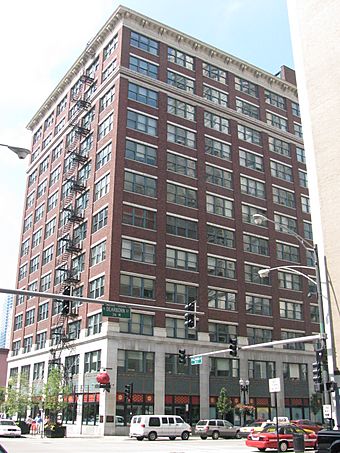Boyce Building facts for kids
Quick facts for kids |
|
|
Boyce Building
|
|
 |
|
| Location | 500--510 N. Dearborn St., Chicago, Illinois |
|---|---|
| Area | 0.3 acres (0.12 ha) |
| Built | 1915 |
| Architect | Daniel H. Burnham & Co., Christian A. Eckstrom |
| Architectural style | Classical Revival, Chicago, Commercial Style |
| NRHP reference No. | 96000080 |
| Added to NRHP | February 29, 1996 |
The Boyce Building is an old and important building in Chicago, Illinois. It's famous because it was home to William D. Boyce's publishing company. He printed newspapers and magazines for people in small towns. This building was also the main office for his special group called the Lone Scouts of America.
Contents
Building the Boyce Building
The Boyce Building is a tall, twelve-story office building. It's covered in light gray granite and red bricks. The building has a strong steel frame. You can find it on the southwest corner of Dearborn and Illinois Streets in Chicago's Near North Side.
How the Building Was Designed
The building was actually built in three steps between 1911 and 1923. William D. Boyce first asked a famous architect, Daniel H. Burnham & Co., to design it in 1911. The first part of the building, which was four stories tall, was finished in 1912. It was built next to another building where Boyce had his offices. Later, that older building was taken down. The second part of the four-story building was completed in 1914.
Printing and Production
The basement of the Boyce Building had a power plant. On the first floor, there were five huge printing presses and a room for sending out mail. This building was amazing because it could print 180,000 newspapers every hour when it was running at full speed!
In 1921, another architect named Christian A. Eckstrom designed an eight-story addition. This part was finished in 1923. Eckstrom used some of Burnham's ideas. This made the building look more complete, even though some fancy decorations were left out. Some of the decorative stone on the roof was removed in the 1980s.
The Story of William D. Boyce
William D. Boyce was born in Pennsylvania and grew up in a small town. He moved to Chicago in 1881. There, he learned a lot about selling and publishing. He started his own weekly newspaper in North Dakota called the Dakota Clipper.
Boyce's Publishing Empire
Boyce became very interested in news for small towns. He teamed up with R. R. Donnelley to create a special printing service. They printed "ready print" stories. These were high-quality stories that small-town newspapers could use. This was much better than what most small towns could afford to print themselves.
Boyce then started a national weekly newspaper called the Saturday Blade in 1887. He later bought out his partners and ran the paper himself. He also bought another story paper, the Chicago Ledger, in 1891. By 1907, he brought all his printing businesses into one building. Boyce used a network of paperboys to deliver his newspapers. In the 1910s, about 30,000 boys in the United States and Canada helped him deliver papers!
The Birth of Scouting
While on a business trip in London, Boyce met a Boy Scout. He was so impressed that he sought out the founder, Robert Baden-Powell. Boyce learned about the Boy Scouts' activities and decided to bring the idea to America.
When he returned to Chicago, he helped start the Boy Scouts of America. He later agreed to let the Y.M.C.A. take over the organization. Boyce wanted to keep printing the Boy Scouts' magazine, Boys' Life, at his building. However, the Y.M.C.A. decided to print it elsewhere.
The Lone Scouts and Beyond
Even though his time with the Boy Scouts was short, Boyce soon started a similar group called the Lone Scouts of America. This group was special because it focused on kids in small towns. These were the kids that the main Boy Scout group often missed. Boyce published the Lone Scout magazine right there in the Boyce Building. By 1919, there were 300,000 Lone Scouts!
However, as technology improved in the 1920s, small towns felt less isolated. This meant fewer kids joined the Lone Scouts. The original Boyce Building was only four stories tall, even though plans were made for it to be ten stories. Boyce didn't think he needed the extra space at the time.
Later, Boyce needed more money. So, in 1921, he had the rest of the building constructed. It was finished two years later. In 1924, the Lone Scouts joined with the Boy Scouts. William D. Boyce passed away in his apartment on the top floor of the Boyce Building on June 11, 1929.
The Boyce Building is very important because it's the only building left that is connected to William D. Boyce's publishing and scouting work. All his other offices and homes have been torn down. The most important time for the building was from 1912, when the first part was built, until 1929, when Boyce died. The building was officially recognized as a historic place on February 29, 1996.
Images for kids





